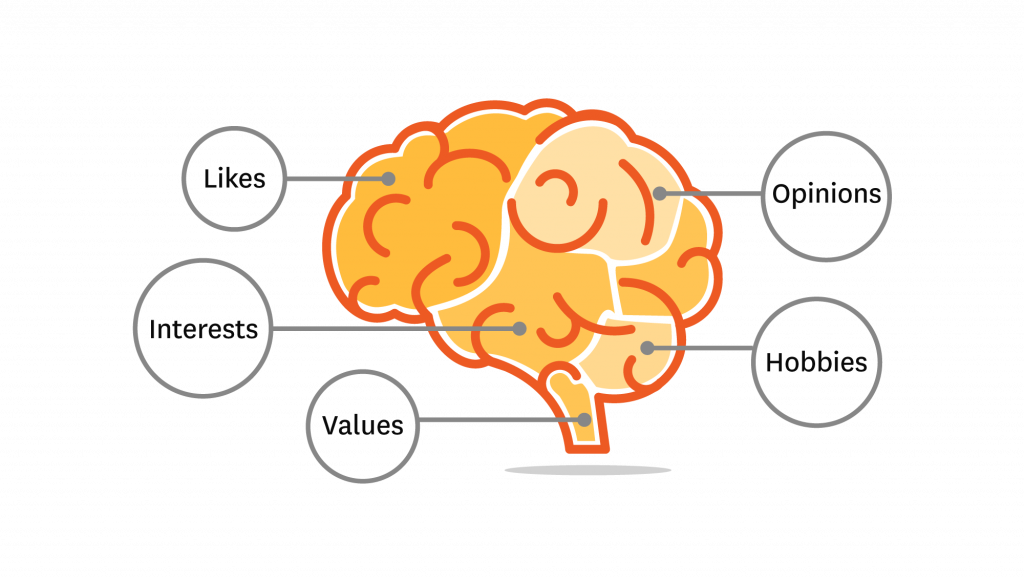
Simple visualization of psychographics
Traditional demographic data—such as age, gender, and location—can offer a useful snapshot of who your customers are, but it often lacks the depth needed to drive effective marketing and product development. Then, you have psychographic segmentation, a powerful approach that delves into the lifestyles, values, interests, and attitudes of individuals to provide a more nuanced understanding of your audience. This blog post will explore how Survey2Persona can help you leverage psychographic data to create detailed and actionable personas.
Understanding Psychographics
Psychographics move beyond surface-level demographic data to include the psychological attributes of your audience. These attributes encompass lifestyle choices, values, interests, opinions, and attitudes that influence consumer behavior. By integrating psychographic data into persona creation, you can gain insights that reveal why your customers make certain decisions, what motivates them, and how they prefer to engage with your brand. Some of the key benefits of this form of data include:
–Enhanced Personalization: Tailor your marketing strategies and product offerings to align with the specific needs and preferences of different audience segments.
– Deeper Insights: Understand the underlying motivations and values that drive consumer behavior, leading to more effective engagement.
– Increased Relevance: Create content and campaigns that resonate on a personal level, increasing the likelihood of conversion and loyalty.
To effectively capture psychographic data, start by designing a comprehensive survey that includes questions about your audience’s hobbies, interests, values, lifestyle choices, and opinions. Unlike demographic questions that focus on “who” your audience is, psychographic questions aim to uncover “why” and “how” they think and behave the way they do.
Example Questions for Psychographic Surveys:
– Hobbies and Interests: “What are your favorite leisure activities?” “Which hobbies do you engage in regularly?”
– Values: “Which of these values is most important to you?” “How important is sustainability in your purchasing decisions?”
– Lifestyle Preferences: “Describe your typical weekend activities.” “How do you prefer to spend your free time?”
– Attitudes and Opinions: “What are your views on emerging technologies?” “How do you feel about the current trends in fashion?”
Survey Design Tips:
– Use a mix of question types including multiple-choice, Likert scales, and open-ended questions to gather diverse insights.
– Ensure questions are clear and concise to avoid confusion and misinterpretation.
– Include follow-up questions to dive deeper into initial responses for richer data.
Once your survey is complete and responses are collected, the next step is to upload this data to Survey2Persona. This platform is designed to transform complex data into actionable personas through intuitive and powerful analytics.
How to Use Survey2Persona for Psychographic Analysis:
1. Upload Data: Log in to Survey2Persona and navigate to the data upload section. Select your file (CSV, Excel, etc.) and upload it.
2. Select Variables: Choose the psychographic variables from your survey that are most relevant to your analysis. This might include questions related to values, interests, and lifestyle choices.
3. Persona Creation Method: Use the Comprehensive Persona Creation method to integrate these psychographic variables into persona generation. This method allows you to create detailed personas that reflect both the demographic and psychographic dimensions of your audience.
Survey2Persona will analyze the psychographic data and generate personas that embody the distinct attributes of your audience segments. These personas will provide a holistic view of your customers, combining both demographic and psychographic information to create a full picture of who they are and what they value.
The real value of psychographic personas lies in their application. Use the insights from these personas to inform your marketing, product development, and customer engagement strategies.
How to Apply Psychographic Insights:
– Tailored Content: Develop content that resonates with the values and interests of different personas. For instance, create eco-friendly product highlights for “Emma”, whose description describes her as an eco-friendly individual, and tech reviews for “Tim”, whose description describes him as a tech / computer geek.
– Targeted Marketing: Design marketing campaigns that speak directly to the psychographic characteristics of your audience segments. This might include personalized email campaigns, targeted social media ads, or specialized promotions.
– Product Development: Use persona insights to guide product features and enhancements that align with the preferences of different audience groups. For example, develop new product lines that appeal to health-conscious consumers or tech enthusiasts.
Harnessing psychographic segmentation with Survey2Persona empowers you to delve into the heart of your audience’s motivations and behaviors. By integrating lifestyle choices, values, and attitudes into your persona creation process, you move beyond superficial demographic data to reveal the true essence of your customers. This depth of insight allows for highly personalized and resonant marketing strategies, fostering genuine connections with your audience. With Survey2Persona, you can craft nuanced personas that serve as a dynamic compass, guiding you toward more impactful engagement and sustained loyalty.
Discover the full potential of your audience with a psychographic lens and let Survey2Persona (Survey2Persona: A tool for analysis of survey data (qcri.org)) illuminate the path to smarter, more empathetic customer interactions.
Read some research!
Salminen, J., Santos, J., Jung, S. G., and Jansen, B. J. (2020) Does a Smile Matter if the Person Is Not Real?: The Effect of a Smile and Stock Photos on Persona Perceptions. International Journal of Human-Computer Interaction, 36(6), 568-590.
Yoganathan, V., Salminen, J., Jansen, B. J. and Jung. S.G. (2019) Machine learning approach to auto-tagging online content for better customer value: A comparative analysis between methods and content type. Journal of Business Research. 101 (2019), 203–217.
Salminen, J., Jung, S.G., An, J., Kwak, H., Nielsen, L., and Jansen, B. J. (2019) Confusion and Information Triggered by Photos in Persona Profiles. International Journal of Human-Computer Studies. 129 (2019), 1-14.
An, J., Kwak, H., Salminen, J., Jung, S.G., and Jansen, B. J. (2018) Imaginary People Representing Real Numbers: Generating Personas from Online Social Media Data. ACM Transactions on the Web. 12, 4, Article 27.

